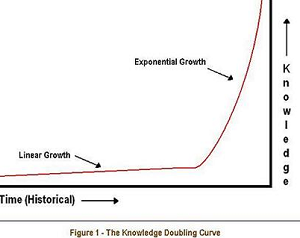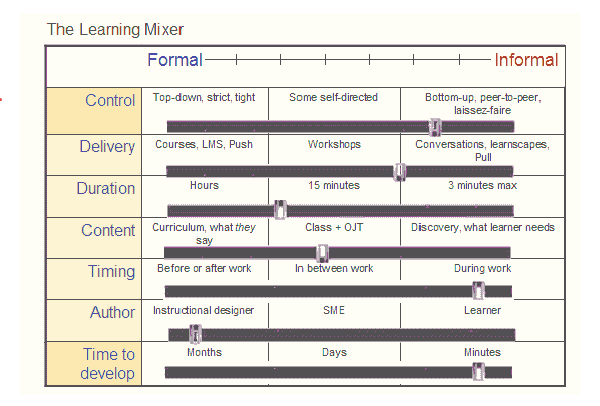ATD Blog
Science of Learning 101: Are We Doing the Right Things?
Mon Jun 15 2015

Currently, corporate learning and development (L&D) is still skewed heavily toward building courses and content, but this approach is not really in sync with the exponential rate of knowledge change and today’s knowledge-heavy work processes—or the instructional "piecework" L&D provides. Consequently, L&D is dangerously close to becoming irrelevant in many organizations.
The Knowledge Doubling Curve
In the early 1980s, futurist and writer R. Buckminster Fuller described a Knowledge Doubling Curve, noting the changing rate of growth in knowledge. He noted that knowledge doubled approximately every century before 1900, but doubled every 25 years at the end of World War II. Today the growth of knowledge is exponential.
Figure 1. The Knowledge Doubling Curve

Different types of knowledge grow at different rates. However, on average, knowledge is doubling close to yearly, and the rate of growth is increasing even faster. This rate of knowledge growth has far-reaching implications for supporting learning in the workplace. The way we currently build instructional content may be adding to the problem—not helping it. Ask people if the training we provide is valuable or helpful, and the answer is usually no.
Jane Hart, the Founder of the Centre for Learning & Performance Technologies has asked more than 3,500 people to rate the importance (value) of 10 typical learning methods used in the workplace (see Figure 2 below).
Figure 2: Jane Hart’s Learning in the Workplace Survey Results

According to the data, Company Training/E-Learning (10) is lowest valued way to learn at work, Meanwhile, knowledge sharing within your team (1) is the most valued way to learn at work. This data begs the question: What are the implications for training organizations and L&D professionals?
Here are my thoughts on the issue…
What people do for their jobs is no longer fixed or stable. (And if it is, automation will likely become involved in the future.) Previously, rapid skill change was reserved mainly for senior-level jobs, but now even lower-level jobs require regular reskilling as people learn new systems, new processes, new techniques, and so forth. Tasks that still require human thinking but don’t require regular reskilling often offer low wages and minimal growth potential.
Typical training processes do not work for the most of the tasks and work that people must accomplish in today’s workplace. Organizational leaders do not understand this fact, and that’s why they continue to ask L&D to build instructional piecework.
Employee Skills Gap
As if this situation isn’t challenging enough, research (see Resources) shows that many employees enter the workforce missing major skills they need, including technical skills, communication skills, and writing skills. What’s more, by the time most people complete college, a fair amount of what they have learned in their major is outdated. That’s how fast information in most fields is growing.
Many jobs that exist today didn’t even exist 20 years ago, such as app designer, user experience analyst, social media specialist, SEO specialist, data scientist, and wind farm engineer. What jobs are being created as you read this blog post?
Clearly, there isn’t any way to train for future jobs. We must, however, prepare people workers to have the skills and mindset to continually learn—and be those people ourselves.
L&D Skills Gap
This brings us to the skills gap in the L&D. A critical skill for our field is to know what works to help people and organizations become more effective and efficient at continually learning and reskilling. Fortunately, the science of learning tells us a great deal, yet many practitioners still heavily rely on the practices and traditional training and classrooms of yore. These learning approaches may have worked for jobs that were fixed and stable, but they don’t work for today’s jobs.
People need to control their own learning when they have to learn continually. Jane Hart’s study shows that this is exactly what is happening. There’s simply no time to wait for L&D. If we don’t want to become dinosaurs, we can’t simply rely on e-learning, we must understand how to support rapid knowledge and skill adoption.
Ability to Continually Learn
To help understand this situation, Jay Cross describes a “learning mixer,” which shows seven dimensions of learner-controlled (informal) learning.
Look at the Formal portion of the mixer (far left of Figure 3) where L&D people build learning content (or other stakeholders control learning.) When people need to continually build skills and learn as they go, L&D and top-down stakeholders rarely understand their learning needs. As a result, these workers are forced to take their learning needs into their own hands.
**Figure 3. Learning Mixer, Formal to Informal
**

Moving Forward
Some (many?) people are floundering in today’s very challenging corporate learning environment and we need to help. In future articles, I will discuss what helps people better learn and adapt quickly under these demanding conditions—especially since the educational system doesn’t seem to be keeping up with meeting workplace demands.
Bottom line: This is a good time for insights. What are we doing right? How can the science of learning help? What needs to change?
Resources
These employment skills references will help you understand the situation we are in and why I believe our role is under extreme pressure to change or become irrelevant.
Figure 1. The Knowledge Doubling Curve; http://epoq.wikia.com/wiki/Knowledge\_doubling
Figure 2: Jane Hart’s Learning in the Workplace Survey Results;
Figure 3. Learning Mixer, Formal to Informal; http://www.informl.com/2007/02/09/all-or-nothing
Education to Employment: Designing a System that Works; [http://mckinseyonsociety.com/downloads/reports/Education/Education-to-Employment\_FINAL.pdf
](http://mckinseyonsociety.com/downloads/reports/Education/Education-to-Employment\_FINAL.pdf)
OECD Skills Outlook 2013 First Results from the Survey of Adult Skills; http://skills.oecd.org/OECD\_Skills\_Outlook\_2013.pdf
You've Reached ATD Member-only Content
Become an ATD member to continue
Already a member?Sign In
